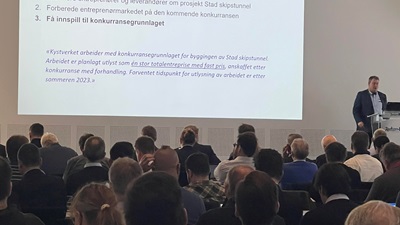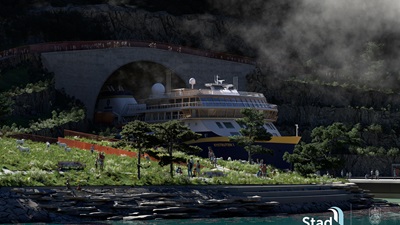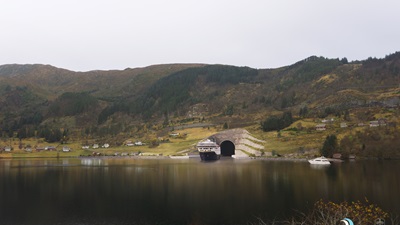“The attendance, commitment and feedback so far show that there is great interest in this project. Many potential partners are considering being part of building the world’s first ship tunnel,” says Terje Skjeppestad, project manager for Stad Ship Tunnel at the Norwegian Coastal Administration.
Preparations for the bidding competition
The Norwegian Coastal Administration is working on the basis for the competition for the construction of Stad Ship Tunnel. It is planned to announce the work as a major design and construct contract with a fixed price, which will be acquired after a competition with negotiation. It is expected to be announced after summer 2023.
The basis for the supplier conference at Gardermoen Oslo, 31.01.2023, was to prepare the contractor market for the forthcoming competition.
“There were three main objectives for the conference. Firstly, we wished to present the project by means of text, images and film and to increase awareness of the ship tunnel and the very extensive and spectacular work that will be happening out at Stadlandet. Secondly, we wished to present details of the contract, the tendering process and the technical issues etc., so as to prepare the contractor market for the forthcoming competition. Last, but not least, we are doing this to get feedback and input for our competition documents,” says Terje Skjeppestad.
A useful conference
The conference was attended by about 80 different suppliers and contractors from both Norway and abroad. In total, more than 160 people came to see and to hear about the Norwegian Coastal Administration’s work on building the world’s first ship tunnel.
“We think the attendance is absolutely fantastic. We are also pleased to note that many of the specialist subcontractors were talking to the big contractors in the mingle session after the presentations. This too was one of the aims of the conference. Many of these subcontractors have smart and useful solutions for different parts of the ship tunnel contract and it is good that these suppliers could get together with the big contractors. Together, they may be part of building Stad Ship Tunnel,” says Skjeppestad.
After the plenary session, the biggest contractors were invited to take part in one-on-one meetings with the Norwegian Coastal Administration’s project team. There will be a total of 13 such meetings in the next few days.
“We have made preliminary tendering documents available and sent out some concrete questions ahead of these meetings, so we hope and believe that the contractors are well prepared to give us some useful feedback,” says Skjeppestad.
What happens next?
“The final deadline for the contractors to give us written input to the preliminary competition documents is 15 February. After that, we will continue work on finalising the basis for tendering. The aim is to announce the competition for the design and construct contract in the third quarter of 2023 and possibly sign a contract during the third quarter of 2024,” says Skjeppestad.
The Stad Ship tunnel project
Stadhavet Sea is the most exposed and treacherous stretch of water along the Norwegian coast. The goal of the project is to ensure a safer passage through Stad.
KEY FIGURES
- Length: 1700 metres for the tunnel run. 2200 metres from the tip of the lead construction to the tip at the other side.
- Height from base to ceiling: 50 metres
- Width between the walls of the tunnel: 36 metres
- Height from sea surface to ceiling: 33 metres
- Cross-sectional area: 1661 m²
- Volume of rock to be removed: Approx. 3 million m³. Equal to approx. 5,4 million m³ of blasted rock – which is equal to approx. 750 000 lorry loads.
- Estimated cost of construction: Approx. NOK 2,8 billion (2021)
- Estimated construction time: Approx. 5 years
CONSTRUCTION
Conventional blasting, with tunnel drilling rigs and bench rigs, is planned.
Three different alternatives for the use of rock masses from the tunnel construction are being investigated, including the establishment of a new commercial area locally.
THE PROJECT
- The Norwegian Coastal Administration devised a concept study (KVU 2010) covering the following alternatives: ‘The zero alternative’ (with no new measures), ‘Small tunnel’ and ‘Big tunnel’.
- A quality assurance process (KS1 report) has also been carried out for KVU 2010, commissioned by the Ministry of Trade, Industry and Fisheries and the Ministry of Finance.
- In the National Transport Plan 2014-2023, the Government said that they wanted to proceed with a preliminary project for KS2, based on the ‘Big tunnel’ alternative. This was considered to have greater potential benefits.
- Positive effects, such as the value of moving traffic from road to sea, safety and increased tourism, as well as positive effects for the fishing industry and other industries have not been calculated.
- Stad ship tunnel will be the world’s first full-scale ship tunnel of this size.
- In 2017 Norconsult AS and Dr. Techn. Olav Olsen AS delivered a technical preliminary project for the ship tunnel. The report includeed the topics lead structures, entrance structures, road bridges, portals, excavation and embankment, sailing through the tunnel, roads, electrical and telecommunications installations, fire and risk, ventilation, landscape designs and the environment
- In the National Transport Plan 2018-2029, the Stad ship tunnel was included with a cost framework of NOK 2.7 billion. NOK 1.5 billion is included in the first part of the National Transport Plan, for the period 2018 to 2023.
- The Norwegian Coastal Administration delivered its preliminary project to the Ministry of Transport in the spring of 2017. The project has been through external quality assurance phase 2 (KS2).
- The Norwegian Coastal Administration carried out a project optimisation, with delivery on 15 June 2019, which resulted in a significant cost reduction.
- In 2020, an extended quality assurance process (KS2) was carried out on the results of the project optimisation.
- In February 2021, the Norwegian Coastal Administration received the letter of commission from the Ministry of Transport, which gave the green light to start preparations for construction. In March, the Ministry presented the proposition to the Storting on construction.


